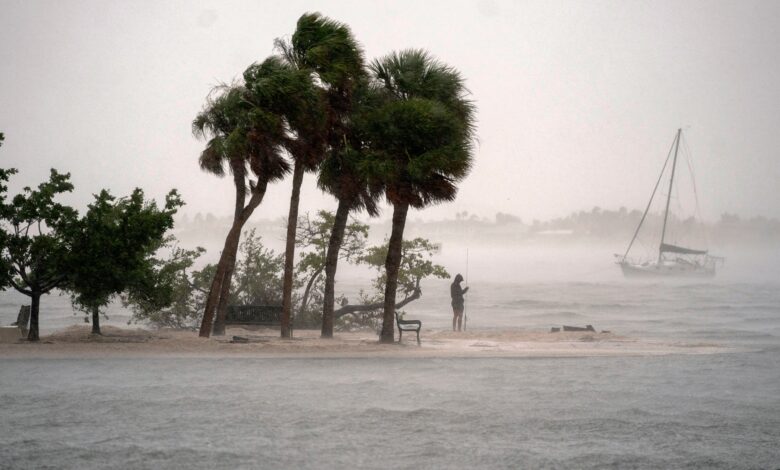Why You Should Never, Ever Go Swimming in the Ocean Right After a Hurricane

In the weeks following Hurricane Ian in 2022, local health agencies—including those in Ft. Meyers, Florida, a place I frequently visit—warned beachgoers to stay out of the ocean because it was teeming with debris, untreated wastewater, and other pollutants. And yet, there were still reports of people wading in the surf (something I witnessed firsthand). That’s a big deal: Some people were hospitalized with issues stemming from dirty water following the hurricane, whether ingesting or wading through it—and a handful of folks even died.
After Hurricane Milton recently made landfall near Siesta Key, Florida, I worried about all the people who might underestimate the seriousness of the situation, even after the storm had passed. “It’s really not safe to be in the waters after a hurricane,” Norman Beatty, MD, FACP, an assistant professor of medicine at the University of Florida College of Medicine, tells SELF. The Florida Department of Health also issued a blanket advisory warning locals to stay out of the ocean.
So why is post-hurricane seawater so gross—and when will it be safe to swim again? Here’s everything you need to know.
How the ocean gets so filthy after a major storm
Hurricanes are tropical cyclones typically categorized with a 1 to 5 rating based on wind speed. A category 1 storm, for example, generates gusts anywhere between 74 and 95 miles per hour, while a category 5 (the most intense) causes it to swirl at a whopping 157 miles per hour or higher. Hurricane Milton was a category 3 hurricane, which means that winds got to 129 miles per hour.
This all causes the tides to pick up, pulling ocean water onto land (called a storm surge), which combines with excess rainwater. All that water mixes with chemicals already on the ground, like pesticides, oils, and fertilizers, as well as debris blown off battered houses, trees, and buildings during the storm. Sewage can also burst from underground pipes, littering the water with E. coli, Campylobacter, Salmonella, and norovirus—“the list goes on and on,” Rachel Noble, PhD, a molecular microbiologist who researches water quality and extreme events at the UNC Institute of Marine Sciences, tells SELF. After the hurricane passes, water slowly retreats into the ocean, Dr. Beatty says, transforming the sea into a slurry of hazards.
Why getting into post-hurricane water is so dangerous
If you have a cut anywhere on your body and get into contaminated water, you could develop a skin problem, like cellulitis, which is a deep tissue infection, Dr. Beatty says. (You might also develop a rash from chemical exposure even if you don’t have a cut.) If you accidentally get seawater in your mouth, you could ingest Salmonella, which can cause diarrhea, fever, nausea, and abdominal cramps.
There’s a type of bacteria, called Vibrio vulnificus that can be found in warm, coastal waters. It’s typically not a huge problem, but when there are high temperatures (as is often the case with tropical storms), vibrio can proliferate, Dr. Noble says. Coming into contact with the bacteria can sometimes be “life-threatening” after hurricanes, Dr. Beatty says, causing a condition called vibriosis. This occurs when the bacteria get into your skin through a wound, causing redness, pain, swelling, warmth, and oozing at the infection site. (You can also get it from eating contaminated oysters.) But if the bacteria move into your bloodstream, you could see a fever, chills, blistering skin lesions, dangerously low blood pressure, or even sepsis (a.k.a. when your immune system has a life-threatening reaction to the infection). Worth noting: Being immunocompromised—say, you have diabetes—makes sepsis from this kind of infection a lot more likely. “Hurricane Ian resulted in 65 vibrio cases and 11 deaths, and we do not want a repeat of that during the current hurricane event,” Antarpreet Jutla, PhD, an associate professor in the department of environmental engineering sciences at the University of Florida, tells SELF.
Dr. Beatty once had a patient who was simply splashed with contaminated post-storm water, which eventually got into a wound, and led to an infection and septic shock. He tested positive for vibrio in the ICU and eventually underwent skin debridement, a surgical procedure that removes infected and dead tissue. Weeks later he received grafts to replace the damaged skin on his arms and legs. From a splash.
So when is it safe to go swimming again?
Aside from local authorities actually telling you, or if there’s a weird look or smell to the water, there really aren’t any glaring clues that your beach is in bad shape, Dr. Beatty says. Some hurricanes cause murky water in their immediate aftermath—as you can see from this visual from NASA of polluted water seeping back into the ocean after Hurricane Florence—but just because something looks harmless, doesn’t mean it actually is, he stresses. It’s also unclear how long the water will stay iffy, says Dr. Jutla—it could get better in days, but it’ll likely remain contaminated for weeks, potentially months.
Even when you get the official green light to get into the ocean again, it’s not a bad idea to take extra precautions. If you have a wound, even a small scratch, avoid swimming until it’s healed. If you really need to get in, seal off any abrasions with a waterproof bandage and clean them thoroughly with soap and water as soon as you get out of the water, Dr. Beatty says: “It only takes a moment in time to be exposed to the wrong bacteria.” It can help to wear protective footwear (like those aquatic shoes with rubber soles) to avoid stepping on something that may cut or scrape your skin.
If you somehow are exposed to potentially contaminated water and develop symptoms—say, your skin becomes irritated and painful or you have diarrhea and vomiting—visit an urgent care clinic or an emergency room department ASAP. A lot of people put off care for too long, says Dr. Noble—“they go to bed with the infection hoping it’ll get better in the morning, and by then, it can be too late.” The bottom line: Obey beach signage and public guidance when it comes to swimming in the ocean after a hurricane. If you really need your fix, head to the pool instead!
Related:



